Car Wheel Sizing: Understanding Bolt Patterns
March 17, 2023
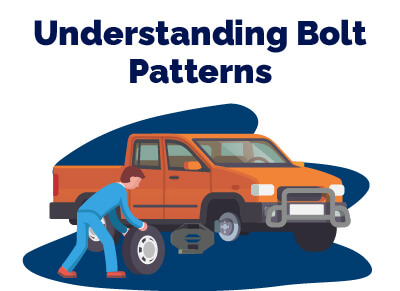

Michael Collado is a car buying expert and has been a professional automotive writer since 2009. He’s written about dealership sales, vehicle reviews and comparisons, and service and maintenance for over 100 national automotive dealerships. Previously, Collado was a copywriter at the ad agency TBWA/Chiat/Day where he worked on brand campaigns for Nissan, ABC Television, Sony PlayStation, and Energizer. His recognition in the ad industry includes awards from Communication Arts and The Clios.
Collado has a Bachelor’s degree from the University of South Florida, with a major in Psychology and a minor in Marketing.
Make sure you understand bolt patterns before determining which car wheels are right for your vehicle
Choosing the right wheels is not just about aesthetics. It also involves understanding the technical aspects of car wheel sizing, including bolt patterns.
We'll show you everything you need to know about bolt patterns, including how to measure them, the different types of bolt patterns, and how to choose the right wheels for your vehicle.
Table of Contents
What Are Bolt Patterns?
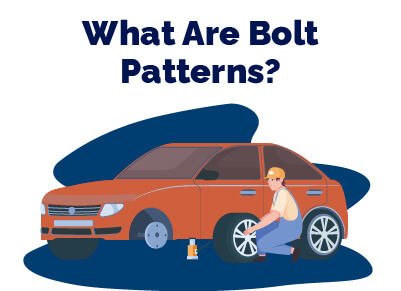 A bolt pattern refers to the arrangement of the lug nut holes on the wheel. It's measured in millimeters and consists of two numbers separated by an "x," indicating the number of bolt holes and the diameter of the circle they form.
A bolt pattern refers to the arrangement of the lug nut holes on the wheel. It's measured in millimeters and consists of two numbers separated by an "x," indicating the number of bolt holes and the diameter of the circle they form.
For example, a 5x114.3 bolt pattern means the wheel has five bolt holes, and the diameter of the circle formed by these holes is 114.3mm.
Bolt patterns matter because they must match the hub of the vehicle precisely. When the bolt pattern is incorrect, the wheel will not mount correctly on the hub, causing vibration, wheel wobbling, and even accidents.
To measure the bolt pattern of your vehicle, you need to measure the distance between two opposite lug holes' centers. The measurement must be in millimeters to accurately match the wheel’s bolt pattern.
Different Bolt Pattern Types
There are different types of bolt patterns available in the market, but some are more common than others. Here are some of the most popular bolt patterns:
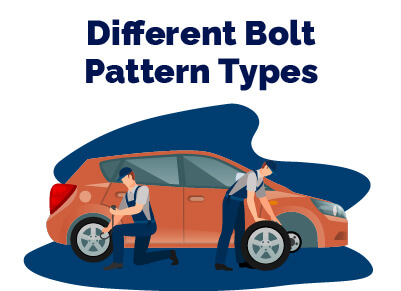 4x100 - Used on many small cars, such as Honda Civic, Volkswagen Golf, and Toyota Corolla.
4x100 - Used on many small cars, such as Honda Civic, Volkswagen Golf, and Toyota Corolla.- 5x114.3 - Used on many Japanese vehicles, such as Nissan, Infiniti, Mazda, and Honda.
- 6x139.7 - Used on many pickup trucks and SUVs, such as Toyota Tacoma, Nissan Frontier, and Ford F-150.
- 8x165.1 - Used on heavy-duty trucks, such as Chevy Silverado, GMC Sierra, and Dodge Ram.
- 5x100 - Used on many small cars, such as Subaru Impreza, Scion TC, and Toyota Prius.
- 5x112 - Used on many European vehicles, such as Audi, Mercedes-Benz, and Volkswagen.
It's essential to know your vehicle's bolt pattern before purchasing new wheels to ensure they match.
Terms You Should Know
When working with car wheel sizing and bolt patterns, you will come upon a number of phrases that may need to be clarified.
Here’s a look at the definitions of certain car wheel and bolt pattern-related phrases you will need to know.
-
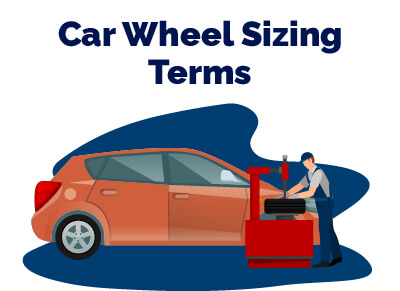 Bolt patterns: Bolt patterns refer to the number of bolt holes and their spacing on a wheel that is used to mount it to the hub of a vehicle. Bolt patterns are expressed in terms of the number of bolt holes and the diameter of a circle that passes through their centers. Bolt pattern adapters will help address any compatibility issues.
Bolt patterns: Bolt patterns refer to the number of bolt holes and their spacing on a wheel that is used to mount it to the hub of a vehicle. Bolt patterns are expressed in terms of the number of bolt holes and the diameter of a circle that passes through their centers. Bolt pattern adapters will help address any compatibility issues. - Wheel studs: Wheel studs are threaded bolts that protrude from the wheel hub and provide a mounting point for the wheel. The lug nut is threaded onto the wheel stud to secure the wheel to the hub.
- Lug nuts: Lug nuts are the fasteners that secure the wheel to the hub by threading onto the wheel studs. Lug nuts come in a variety of shapes and sizes, and it is essential to use the correct type for a specific wheel and hub.
- Vehicle fitment: Vehicle fitment refers to the compatibility of a particular wheel with a specific make and model of vehicle. Vehicle fitment includes considerations like bolt pattern, wheel size, offset, and load capacity.
- PCD (Pitch Circle Diameter): PCD is the diameter of the circle that passes through the center of each bolt hole on a wheel. PCD is often used to describe the bolt pattern of a wheel, and it is an essential measurement for ensuring that a wheel fits correctly on a particular vehicle.
- Wheel offset: Wheel offset is the distance between the centerline of the wheel and the mounting surface where the wheel attaches to the hub. Positive offset means the mounting surface is closer to the outside of the wheel, while negative offset means the mounting surface is closer to the inside of the wheel.
Choosing the Right Wheels
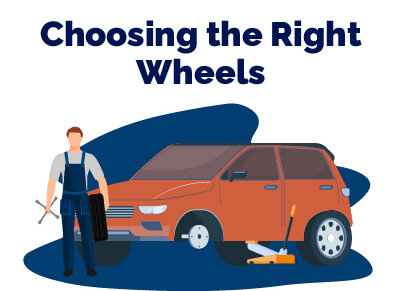 Choosing the right wheels for your vehicle involves considering various factors, such as wheel size, offset, and material. However, the most crucial factor is matching the bolt pattern to the vehicle's hub.
Choosing the right wheels for your vehicle involves considering various factors, such as wheel size, offset, and material. However, the most crucial factor is matching the bolt pattern to the vehicle's hub.
When purchasing new wheels, make sure the bolt pattern matches your vehicle's hub. It's also essential to consider the wheel's size, ensuring it fits the wheel well, and the offset is appropriate for the vehicle. Additionally, make sure the wheel's weight capacity meets or exceeds your vehicle's requirements.
When installing new wheels, ensure they are centered and tightened to the correct torque specification. Failing to do so can cause vibration, wheel wobbling, and even accidents.
Best Car Deals by Category
Frequently Asked Questions
Why is the bolt pattern important when choosing a new wheel?
The bolt pattern is crucial when choosing a new wheel because it determines whether the wheel will fit on the vehicle or not. If the bolt pattern is incorrect, the wheel will not mount correctly on the hub, leading to safety issues, vibration, and damage to the vehicle.
How do I know which size wheels will fit my car?
To know which size wheels will fit your car, you need to check your vehicle's owner's manual or contact the manufacturer for specifications. You can also measure the current wheel size or bolt pattern to ensure compatibility.
What is the difference between a 4-lug and a 5-lug bolt pattern?
A 4-lug bolt pattern has four equally spaced lug holes arranged in a circle, while a 5-lug bolt pattern has five equally spaced lug holes arranged in a circle. The number of lug holes and their spacing determines the bolt pattern.
How do I install new wheels with the correct bolt pattern?
To install new wheels with the correct bolt pattern, you need to ensure the bolt pattern of the wheel matches your vehicle's hub. You should also ensure the wheel size, offset, and weight capacity are suitable for your vehicle. Finally, you need to properly center and torque the wheels to the manufacturer's specifications.
Can I use wheel spacers to adapt a different bolt pattern?
While wheel spacers can adapt to a different bolt pattern, they are not recommended as they can cause stress on the wheel bearings and potentially cause safety issues. It's always best to choose wheels with the correct bolt pattern.
How do I properly torque my wheels after installation?
To properly torque your wheels, you need to use a torque wrench and tighten the lug nuts in a star pattern to ensure even torque distribution. Follow the manufacturer's torque specification for your vehicle to avoid over-tightening or under-tightening the lug nuts.
Posted in Car Buying Tips |




